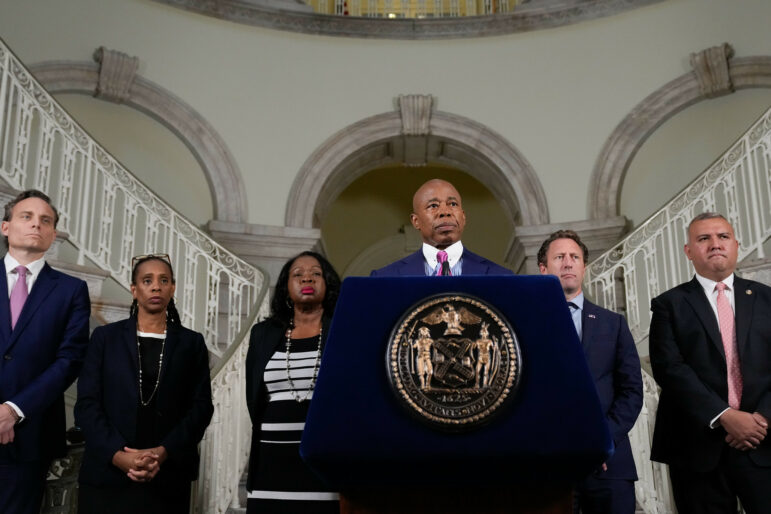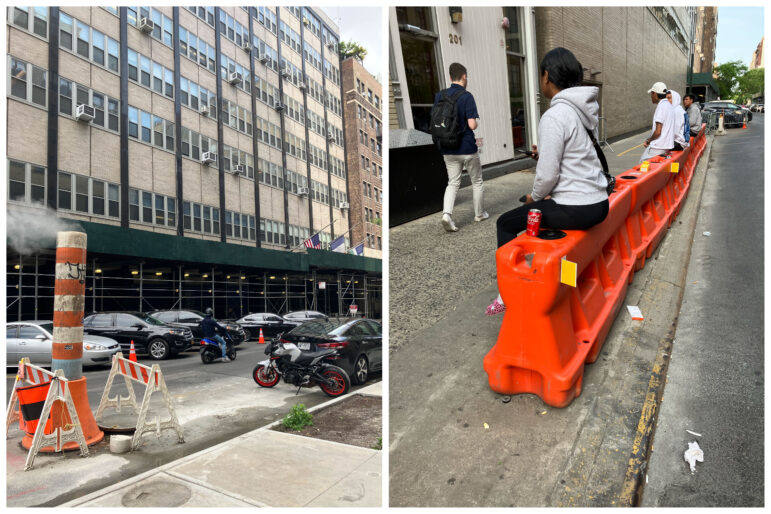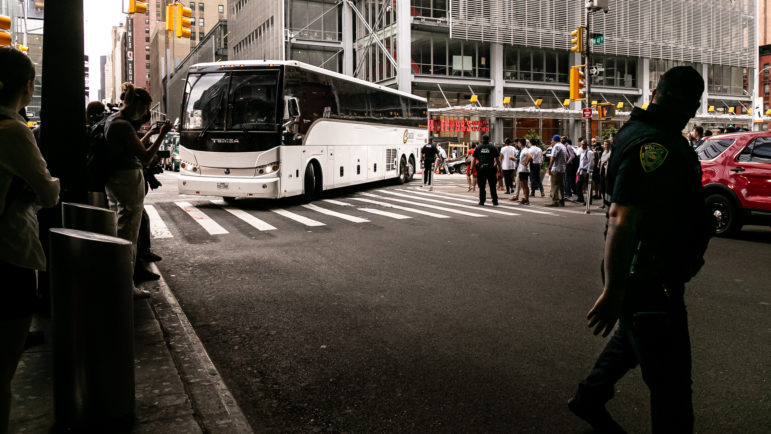The mayor defended the move, saying the city had little choice as it struggles to keep up with a ballooning shelter population. But advocates say the change undermines the city’s social safety net and protections to ensure homeless families with children have access to safe conditions.

NYC Mayor’s Office
Mayor Eric Adams addressing the asylum seeker crisis at an October 2022 press conference.
Wanda, a 21-year-old Venezuelan woman who preferred not to reveal her last name, said that after arriving at LaGuardia Airport by way of Brownsville, Texas, on May 5, she approached a police officer and told him: “I’m looking for a shelter.”
Shortly after, without knowing who had called it—let alone who had paid for it—an Uber arrived and took her to the Department of Homeless Services’ Prevention Assistance and Temporary Housing (PATH) intake center in the Bronx, the first stop for asylum seekers and families experiencing homelessness to access shelter in New York City.
Within minutes, she was told to go to the NYPD’s former Manhattan police academy building on 20th Street, this time without the good fortune of receiving help to get there. Instead, she took the subway, with the aid of a fellow straphanger who provided directions.
The Gramercy Park building is one of the most recent sites the city has tapped to house asylum seekers, more of whom are expected to cross the southern border in the coming weeks as Title 42, a federal COVID-era policy that allowed the U.S. to more easily expel migrants, comes to an end this week. Since last year, more than 60,800 migrants have arrived in New York, with more than 37,500 remaining in the care of the city. Mayor Eric Adams’ administration has been scrambling to open new shelter sites, probing the possibility of erecting temporary housing on city streets and even outside the city limits.
On Monday, the Daily News revealed that the former police academy was being used to house children in congregated settings, an apparent violation of longstanding “right to shelter” rules prohibiting the city from sheltering minors under these conditions. By Wednesday morning, many families with kids had been relocated from the site—where cots had been set up in a gymnasium—but not all of them, according to immigrants who were housed there.
“There were several families here,” Beatriz, 30, told City Limits in Spanish. “Many were moved between Monday afternoon and Tuesday morning.”
On Wednesday, Mayor Eric Adams issued an executive order to suspend some of those unique “right to shelter” rules, Gothamist first reported, citing the strain from the migrant crisis. The mayor’s directive specifically lifts requirements that the city shelter homeless families with children in private spaces that have access to a kitchen and bathroom, as well as another provision aimed at preventing families with kids from having to sleep overnight at an intake center.

Daniel Parra
NYPD’s former Manhattan police academy building on 20th Street, which the city began using as an emergency shelter earlier this week.
Adams’ team has, for the last year, broached the possibility of “reassessing” requirements tied to the city’s landmark right to shelter provisions, established decades ago by a series of court rulings and government policies stemming from a 1979 lawsuit filed by a homeless man named Robert Callahan. Homelessness advocates quickly slammed the mayor’s order, citing the right to shelter as an essential component of New York’s safety net.
READ MORE: What Would NYC Look Like Without Right to Shelter? Bleak, Say the People Who’ve Needed It
The mayor’s order “could force families with children to languish at the City’s intake facility for extended periods of time, potentially days on end, prolonging suffering that no human being should experience,” The Legal Aid Society and Coalition for the Homeless said in a statement. “This order could potentially lead to the City regularly placing homeless families with children in congregate settings, a dangerous and widely condemned practice of the distant past.”
But the mayor defended the move to reporters Thursday morning, saying the city had little choice as it struggles to keep up with a ballooning shelter population. Texas Gov. Greg Abbott resumed sending buses of migrants from his state’s border to New York earlier this month, and the city saw some 4,200 new arrivals last week alone, Adams said.
“No one thought about a humanitarian crisis when they first took this court case of Right to Shelter,” the mayor said. “We’re getting an average of 500 people a day, and Title 42 is not lifted. We could potentially get thousands of people a day in our city.”
Several of those staying at the old Police Academy facility on Wednesday said they were not sure where they would be relocated to next, or how long they would be able to stay after being there for more than five days.
During a City Council budget hearing Monday, Department of Social Services Commissioner Molly Park said families would be relocated from the site in the next 24 to 48 hours, after acknowledging the presence of minors there. But as of Wednesday morning, a couple of families with children had spent an extra night at the group facility, those staying there said. City Hall did not respond to City Limits’ questions about the timing.
But speaking more generally to the media Thursday morning, the mayor characterized some of the city’s right to shelter requirements—including that “every family must have a kitchen and bathroom”—as “just not realistic” in light of the current capacity issues.
“My son went to college in a dorm. He didn’t have his own kitchen and bathroom, and he still did a great job,” Adams said, echoing similar statements he’s made in recent months that appear to challenge the city’s housing and shelter standards, such as building laws that require bedrooms to have windows.
“Our desire’s not to put children and families in dormitory settings—our desire is to manage a humanitarian crisis,” Adams said.
But advocates pushed back against the mayor’s argument. In a statement, former City Council Speaker Christine Quinn, now the head of the homeless nonprofit Women in Need (WIN), said allowing kids to stay in congregate shelters risks putting them “in dangerous situations.”
“You want people to have their own space. You have a bunch of kids running around,” said Maria Walles, a member of the group Safety Net Activists who is formerly homeless herself.
She and other advocates are pushing for the city to prioritize connecting homeless families with housing, rather than shelter. Many have called for lawmakers to amend the rules around eligibility for CityFHEPS, the city’s main rental voucher subsidy, for which non-citizen New Yorkers don’t currently qualify.
“At least…put them in an apartment where they can cook for their family,” Walles said. “This is a major issue that’s going to be traumatizing, especially for the kids.”
At the police academy site, the building’s gym was set up with rows upon rows of green cots where residents received a blanket and a kit with toothpaste, toothbrush, shampoo, and a towel. Jose, 21, who also preferred not to reveal his last name, said that families with babies were given diapers after arriving. The site had meals available, though no kitchen for families to prepare their own food.
Still, of the six residents City Limits spoke to, none complained about the treatment or the conditions of the place. “Here I felt calm and cared for, protected,” said Wanda. “Some policemen speak Spanish and some don’t.”
Immigrants staying there told City Limits they arrived in the city by multiple routes: some were brought there after being transported recently by Texas Gov. Abbott after a months-long busing lull; others received airline tickets to fly from San Antonio; and some arrived by bus from cities such as Denver.

Adi Talwar
A bus from the Texas border arriving at Port Authority in Midtown Manhattan on Aug. 10, 2022.Beatriz, who arrived on a bus from Denver after crossing the border in Texas, says there are more people in Colorado’s capital city ready to come to the Big Apple. “In Denver, there are about 300 people waiting,” said Beatriz in Spanish.
Denver’s Emergency Operations Center and Joint Information Center said the city has sent 190 people to New York since just May 8. “Since the recent significant influx in migrants and asylum seekers this past week, we’ve increased our ticket purchases significantly,” a spokesperson said.
Since January, Denver Human Services estimates the city bought tickets for an estimated 1,005 immigrants to travel to New York, accounting for about a quarter of all the tickets it purchased.
“I have more friends here,” Wanda said of her reason to choose New York, citing a former colleague who’s spent several months at a Manhattan hotel emergency shelter. These friends, she added, have guided her in accessing resources and looking for a job.
As of May 3, Gov. Abbott had sent over 5,300 migrants on over 100 buses to New York, his spokesperson Renae Eze said in an email, representing only a little more than 8 percent of the total number of people who have arrived in the city since last year.
The city of El Paso has sent an additional 7,000 people, though a spokeswoman said El Paso stopped providing “sponsored transportation” in October 2022.
Adams said Thursday that his administration intends to “challenge all of the legal obstacles” impeding its potential shelter plans, including an emergency order passed by a Rockland County executive this week seeking to prohibit the city from sending asylum seekers to hotels there, as the mayor proposed.
“We are feeding thousands of people, over 60,000 that came through our system. Laundry service. The children are being educated. Medical service, mental health support, legal advice. What we’re doing is unprecedented to any other municipality,” Adams said in defending his executive order Thursday.
“If we have to re-examine the law to make it adjust to the real life humanitarian crisis we have, then we have to do that.”









One thought on “Mayor Suspends Some ‘Right to Shelter’ Rules in Scramble to House Asylum Seekers”
Mental health services?
Obamacare has NO mental health services NO therapists, maybe a psychotropic drug otherwise NO psychologist, NO social workers, NO mental health counselors.
These people are NOT receiving mental health services.